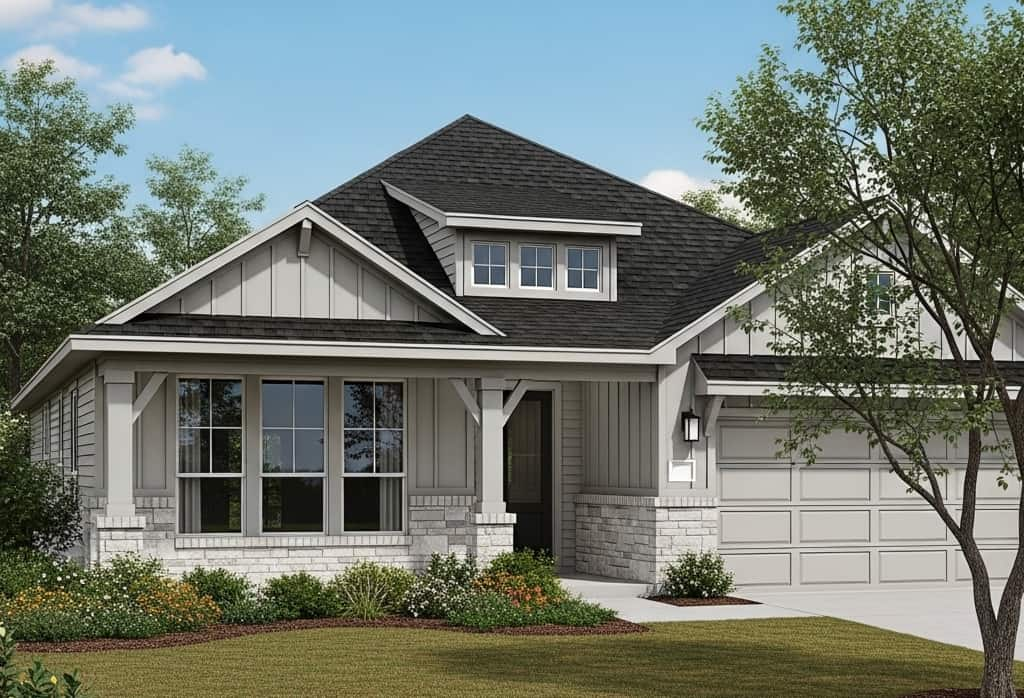What Is a DSCR Loan Texas
A DSCR loan, or Debt Service Coverage Ratio loan, is a financing option for real estate investors who qualify based on the property’s income rather than their personal income. In Texas, investors commonly use a DSCR loan for rental properties, short-term rentals, and other cash-flowing investments. It is a type of investment property loan, not a traditional mortgage for owner-occupants.
Lenders do not focus on your job income or tax returns. Instead, they look at how much net income the property generates divided by its total loan payments. In other words:
DSCR = Property’s Net Operating Income ÷ Total Debt Service.
If a Dallas rental generates enough rent to cover its mortgage plus some extra, your DSCR ratio is strong. For context, a ratio of 1.25 or higher is generally considered a good benchmark. For example, if your property earns $2,000 monthly and your loan payment is $1,500, your DSCR equals 1.33.
This approach enables Texas investors to grow rapidly. Approval depends on rental performance, not your personal employment. Also, Texas offers robust rental markets (cities like Houston, Austin, Dallas) where demand and cash flow potential make DSCR loans more practical.
How DSCR Loan Texas Works
A DSCR loan measures how well a property’s income can cover its debt payments. The formula is simple: DSCR = Net Operating Income ÷ Annual Debt Payments. Net Operating Income refers to the property’s total rental income minus regular operating expenses such as maintenance, taxes, and insurance.
Lenders use this ratio to decide if a rental property can support the mortgage without relying on your personal income. They compare your DSCR to their minimum requirement to gauge how safely the property can cover its loan obligations.
For example, if a Houston rental earns $3,000 a month and the loan payment is $2,000, the DSCR equals 1.5. This means the property generates 50% more income than needed to cover the loan, a strong indicator for approval. A DSCR below 1.0 indicates that the property’s income cannot fully cover the loan, signaling a higher risk.
In Texas, lenders require a DSCR ratio between 1.0 and 1.25, depending on property type and risk level. A ratio of 1.0 means the property breaks even, while anything higher shows positive cash flow. Because Texas rental markets remain stable and diverse, lenders may accept slightly lower DSCRs for properties in high-demand cities. Being aware of how DSCR works helps investors adjust rent or improve the property to strengthen their ratio before applying.
DSCR Loan Texas Requirements
To qualify for a DSCR loan in Texas, lenders primarily focus on the property’s performance, rather than the borrower’s personal income. Unlike conventional loans that depend on your job income and tax returns, DSCR loans emphasize property cash flow.
The first requirement is a solid DSCR ratio, usually 1.0 to 1.25 or higher. A stronger ratio indicates reliable cash flow and lowers lender risk. Banks and private lenders require evidence of rental income. For existing properties, they review verified leases or market rent records. If the property is new or not yet rented, lenders may use market rent projections or appraiser estimates as proof of income.
The property must be investment-focused, not owner-occupied. Borrowers typically require a minimum credit score of 640, which lenders generally consider sufficient to assess reliability and mitigate default risk. Borrowers with scores around 680 or higher can qualify for slightly lower interest rates, 0.25–0.5% below standard rates, and may secure down payments 2–5% lower than standard requirements.
Other requirements include property appraisal, title verification, and a history of on-time mortgage payments, if you already own other rental properties. In Texas, lenders may consider properties with slightly lower DSCR ratios when borrowers provide larger down payments or maintain strong credit, as outlined in their internal risk guidelines. Each lender sets specific standards based on property type, risk tolerance, and local market trends, which is why requirements can vary between programs.
DSCR Loan Texas Down Payment and Loan Terms
In Texas, DSCR loans typically require a down payment of between 15% and 25% of the property’s value. Lower down payment programs usually require a higher DSCR ratio or stronger credit, especially for multi-unit or higher-risk properties. Down payment expectations can also vary depending on property type, such as single-family homes versus multi-unit rentals. For instance, a $300,000 property with a 20% down payment requires an upfront payment of $60,000. In Texas cities like Austin or Dallas, lenders may adjust down payment requirements based on local rental demand and property type.
Loan terms generally include 30-year fixed options, with some lenders offering interest-only periods. Interest-only periods allow for lower initial payments, improving early cash flow, but do not reduce the principal. The loan-to-value ratio typically caps out at around 80–85%. Higher LTV reduces upfront costs but may increase monthly payments and lender risk, so investors must balance LTV with cash flow and repayment capacity.
DSCR Loan Texas Rates
DSCR loan interest rates in Texas range from 6.5% to 8.5%, depending on the lender, property type, and the borrower’s DSCR ratio. A higher DSCR reduces lender risk, which can result in lower interest rates. For example, if a property’s DSCR improves from 1.1 to 1.3, lenders may offer rates at the lower end of the 6.5–8.5% range.
Other factors affecting rates include credit score, loan term, and property location. Fixed-rate loans offer predictable payments, whereas interest-only loans may start lower but do not initially reduce the principal. In high-demand cities like Austin and Dallas, strong rental income can help secure slightly lower rates even with modest credit scores.
Comparing multiple lenders and improving your property’s DSCR before applying can help you secure the best rate. Staying informed on current market trends helps investors maximize cash flow while keeping financing costs manageable.
DSCR Loan Texas Qualification Criteria
To qualify for a DSCR loan in Texas, lenders primarily assess credit score, DSCR ratio, and property income. Banks and private lenders typically require a minimum credit score of 640. Borrowers with scores around 680 or higher can qualify for slightly lower interest rates, 0.25–0.5% below standard rates, and secure down payments 2–5% lower. In high-demand Texas rental areas, lenders may evaluate properties with slightly lower DSCR ratios when borrowers provide larger down payments or maintain strong credit, as long as these meet their internal risk guidelines.
The property’s rental income must comfortably cover loan payments. Lenders require a DSCR of 1.0 or higher, while a DSCR of 1.25 or higher is viewed as strong and can improve approval chances.
Additional factors include the loan-to-value ratio, property appraisal, and verification of leases or rental agreements. Loan-to-value ratios, property appraisals, and verified leases help lenders assess risk and property reliability. Maintaining a clean mortgage history and consistent property cash flow strengthens your qualification and increases your likelihood of approval.
DSCR Loan Texas Pros and Cons
Pros
- Approval focuses on property income. Focusing on property income allows investors to qualify even if their personal income is inconsistent or they have multiple loans.
- Allows for faster portfolio growth since personal tax returns and employment verification are not primary factors in determining investment decisions.
- Flexible for various property types. This flexibility encompasses single-family homes, multi-unit rentals, and short-term rentals, which are common in Texas.
Cons
- Interest rates are higher than those for conventional loans, ranging from 6% to 8%, reflecting a higher risk to lenders.
- Down payments range between 15% and 25%, depending on the DSCR ratio and credit. A higher DSCR may allow for slightly lower down payments.
- Not suitable for owner-occupied properties; use is limited to investment or rental properties only.
High rental demand in Texas cities makes DSCR loans attractive for investors seeking cash-flowing properties.
Best DSCR Loan Texas Lenders and Programs
Several lenders specialize in DSCR loans for Texas investors. DSCR lenders include traditional banks, private lenders, and non-QM programs, each offering varying levels of flexibility and rates. Notable options include New Silver, Griffin Funding, Lima One, Lone Star Financing, and CoreVest. These lenders offer various programs specifically designed for rental properties. Fixed-rate loans provide predictable payments, while interest-only programs can improve early cash flow for investors.
When comparing lenders, consider the interest rates, down payment requirements, loan terms, and the speed of approval. Lenders familiar with local Texas rental markets can better assess property income and expedite approvals. Working with experienced lenders helps investors maximize property income while effectively managing financing costs.
Final Note
DSCR loans in Texas offer a financing option that focuses on property income rather than personal income, making them a suitable choice for real estate investors. High rental demand in Texas cities makes DSCR loans attractive for property investors. Knowing the requirements, down payment options, interest rates, and available lenders helps investors choose programs that maintain positive cash flow and support portfolio growth. Monitoring a DSCR of 1.25 or higher helps ensure positive cash flow and smoother approvals.
You can also explore DSCR loan programs in Florida to compare rates, requirements, and pros and cons here: DSCR Loan Florida.
FAQs About DSCR Loan Texas
What is the downside to a DSCR loan?
Higher interest rates and larger down payments make DSCR loans costlier than conventional financing. They are primarily suitable for investment properties, rather than owner-occupied homes.
What are the requirements for a DSCR loan in Texas?
Lenders require a DSCR ratio of 1.0 or higher. A DSCR of 1.25 or higher is considered strong and may increase the chances of approval. Other requirements include a credit score of 640 or higher, a property appraisal, proof of rental income, and a down payment of 15–25% of the purchase price. Some lenders may accept 15% down with a higher DSCR or strong credit.
Do all DSCR loans require a 20% down payment?
Not always. While 20% is common, some lenders may allow 15% down with a stronger DSCR or higher credit score. Rates and down payment options may vary between cities like Dallas, Austin, and Houston due to local rental demand.
What is the interest rate for DSCR loans in Texas?
Rates generally range between 6.5% and 8.5%, depending on lender, property type, DSCR ratio, and credit score.




